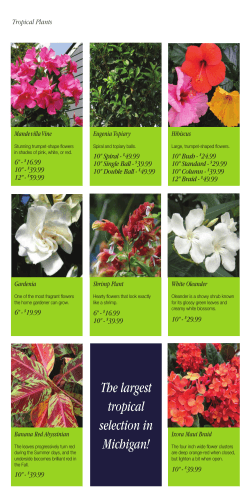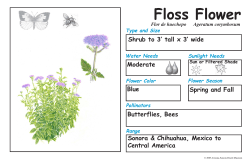
May Issue - The Gesneriad Society
Gleanings
a monthly newsletter from The Gesneriad Society, Inc.
(articles and photos selected from chapter newsletters,
our journal Gesneriads, and original sources)
Volume 6, Number 5
May 2015
Welcome to the latest issue of Gleanings! This issue includes
photos from the Omaha Flower Show, Tsuh Yang Chen's article on
the genus Sinningia, and photos from the African Violet and
Gesneriad Society of Western New York's show.
Hope you enjoy Gleanings!
!
Mel Grice, Editor
!
Ray Coyle, of Glendale, New
York, USA, brought his new
hybrid of Sinningia sp.
"Ibitioca" x S. 'Flair' to the
Long Island Gesneriad Society
May meeting. "I made the
cross in May 2008, and got a
fair amount of seed, but only
one germinated. I wanted to
get a plant intermediate in size and retaining S.
'Flair's bloom coloration. In that aspect I failed, but
the bloom was interesting. Initially the plant
remained small in size. By the fourth year it has
gotten to about 9" tall. It grows under two T8
lights, about 10" from the source. It is kept on a
humidity tray, gets eleven hours of light per day
and is fertilized at every watering at ¼ tsp. per
gallon of water. I hand water all my plants. I will
now work to propagate it and think of a name for
it and register it."
http://gesneriadsociety.org/!
!
!
!
!
May 2015
!
page 1
Omaha Flower Show 2015
Kohleria 'Bud's Solar Flare'
Brandon Erikson
Sinningia 'Anita Baldwin'
Brandon Erikson
All photos by Brandon Erikson
http://gesneriadsociety.org/!
!
!
!
!
May 2015
!
page 2
Kohleria 'Bud's Super Nova'
Brandon Erikson
Episcia 'Noel'
Brandon Erikson
Sinningia 'Li'l Georgie'
Brandon Erikson
All photos by Brandon Erikson
http://gesneriadsociety.org/!
!
!
!
!
May 2015
!
page 3
Nematanthus gregarius 'Golden West'
MJ Bradley
Streptocarpus 'Bud's Grape NeHi'
Brandon Erikson
Epicsia 'Country Cowgirl'
MJ Bradley
All photos by
Brandon Erikson
http://gesneriadsociety.org/!
!
!
!
!
May 2015
!
page 4
The Genus Sinningia
Tsuh Yang Chen piabinha@yahoo.com
Brooklyn, New York, USA
(A presentation by Tsuh Yang Chen at the January 2015 meeting of the Greater New York
Gesneriad Society)
Sinningia is my favorite genus in our favorite family. One of my first introductions to this
genus was the amazing S. leucotricha plants in bloom that were exhibited at the GNYGS
booth in 1994 at the New York Flower Show at the west side piers in Manhattan. I had never
seen the "Brazilian Edelweiss" before and I was amazed at the gorgeous, woolly leaves and
stems. [Of course, before I was seriously interested in houseplants, I knew of the common
florist gloxinias, but these are so common, they almost do not belong to the "exotic"
sinningias we love.] Here is a general introduction to the genus.
Sinningia is a genus in the Gesneriad family that is mostly tuberous — although some species
are fibrous-rooted shrubs (e.g., S. schiffneri) and some produce only rudimentary tubers.
Many species are "stoloniferous," producing satellite tubers (e.g., S. tubiflora), and most
species are lithophytes (growing on rocks) or epiphytes (S. douglasii, S. cooperii), rather
than truly terrestrial. At least one species, S. polyantha, is found growing on a beach in
pure sand!
With over 70 species, the genus spans from Central America all the way south to Argentina;
however, the largest concentration of species are found in eastern and southern Brazil,
where they grow in both the humid Atlantic rainforest and the hilly savannah known as
"campos rupestres" (see http://www.worldwildlife.org/ecoregions/nt0703 for more info on
this habitat). New species are still being discovered to this day in spite of the fact that the
Atlantic rainforest today covers only 7% of its original habitat (and the campos rupestres are
under threat from continuous human activity, such as agriculture, cattle-raising and
mining).
To this genus belongs the very decorative common florist "gloxinia" (S. speciosa), as well as
some miniature species (S. pusilla, S. concinna and S. muscicola), which have been
extensively used in hybridization to produce numerous beautiful smaller-sized hybrids. Many
plants in the genus make attractive houseplants or garden subjects, and those from
southern Brazil and Argentina especially have proven to be hardy to zone 7 (or even 6) in
the U.S. In addition to attractive flowers, some species are grown for their beautiful
pubescent leaves (S. leucotricha, S. hatschbachii, S. canescens, S. piresiana, S. globulosa).
Succulent fanciers also love many species, particularly those with large exposed tubers or
caudices (S. bulbosa, S. macrostachya, S. lineata, S. sellovii). Flower color is mostly red,
although some species have orange, yellow, lavender-purple, green and white flowers (with
or without spots). A few species also have fragrant flowers (in particular, S. tubiflora, some
clones of S. speciosa, S. richii, S. lindleyi and S. guttata).
Some favorite species:
1) High-light species: These species are grown on a south window.
S. aghensis: this plant is not commonly found, and it is unusual for the extremely tall flower
peduncles, the tallest in the genus. Once established, it produces dark purple flowers if
given enough light (which is, desert cactus-level sunlight).
S. sp. "Ibitioca": one of the most attractive species, it tends to be a bit finicky in indoor
cultivation, but has extremely attractive soft, light green leaves and purple flowers.
Related to S. aghensis, it can grow a large tuber, and also easily produces satellite tubers.
http://gesneriadsociety.org/!
!
!
!
!
May 2015
!
page 5
S. speciosa: several clones of this species require higher light, including "São Conrado" and
"Cardoso Moreira" (this last one is also noteworthy for growing a tall stem, instead of a flat
rosette, and it comes in two color forms, pink and purple).
S. bulbosa: growing on the beach in the city of Rio de Janeiro, it has attractive red flowers,
and can grow some of the largest tubers in the genus.
S. tubiflora: easy to grow, makes lots of satellite tubers. It requires strong sunlight to bloom
(some members have reportedly bloomed it under lights).
2) Bright-to low-light species: These are some of the species I have bloomed under a
2-tube (40-watts) light stand or on a bright north window.
S. speciosa: some clones are from shady rainforest floors (such as "Domingos Martins") and
require less light. I have a clone of 'AC1503' that blooms regularly and comes back from
yearly dormancy under the light stand.
S. araneosa: a very attractive plant, with furry leaves and nice bright red flowers.
S. amambayensis: a tall shrub with bright red flowers, but drawbacks with this plant are the
very sticky leaves and stems, and persistent dead leaves (in nature, the dead leaves remain
on the plant to protect it from the cold).
S. nordestina: attractive smallish flowers (red, with yellow throat, spots), looks like a
smithiantha. It comes back every year from small tubers.
S. iarae: lovely cerise flowers, soft foliage. There's also a lighter-salmony clone.
S. eumorpha: various clones, with lovely white flowers, some with more purple and yellow/
green in the throat, attractive dark leaves. A favorite of hybridizers.
S. leucotricha: I was somewhat surprised that mine ("Max Dekking"clone) blooms under such
low-light conditions, but it can also take higher light. A perennial favorite.
S. rupicola: same as above in terms of lighting. A rare species; leaves are distinctly dark,
dull-grayish green.
S. globulosa: lovely furry leaves, unusual flower calyces when in bud (red and furry).
S. defoliata: An anomalous species, it produces an enormous, often-single leaf. It flowers
before the leaves appear, on a bare tuber.
S. richii: tends to produce lots of satellite tubers, also fragrant flowers, but needs more
humidity for more constant blooming under my conditions.
S. aff. reitzii (Iporanga and nearby area): this is a tall shrub, with pink or red flowers, it can
grow a large tuber. It also produces lots of satellite tubers. It is distinguished from the "true"
S. reitzii (a.k.a. 'Corupá' or sp. 'New Zealand') in that it produces a single flower from the
pedicels, whereas S. reitzii has two flowers per pedicel.
S. macropoda: lovely species, soft scalloped leaves; in spite of its name, more of a mediumsized tuber than truly a giant one.
S. cardinalis: also can be grown in higher light, but has bloomed in a north window.
S. guttata: lovely shrub with spotted white flowers; some clones are fragrant. It can be
finicky to come back from tubers. It can also be grown under shadier conditions.
S. lindleyi: a shrub that can also be grown as a succulent as its stem can get quite thick and
large. Distinctive in having green flowers that are fragrant.
S. concinna and S. pusilla: mostly require enclosed growing for more consistent blooming.
http://gesneriadsociety.org/!
!
!
!
!
May 2015
!
page 6
3) Some recommended hybrids:
S. 'Tinkerbells': as someone at the meeting noted, it’s “indestructible.” This small hybrid
blooms well, comes back from dormancy regularly and propagates easily via cuttings. It was
made by a former GNYGS member, Elena Jordan, on her Manhattan apartment windowsill, a
cross of S. aggregata and S. concinna. A must-have plant for all.
S. 'Prudence Risley': a complex hybrid, easy to grow and bloom, with attractive, large red
flowers.
S. 'Amizade': a cross of two small, rare and very beautiful species, S. hirsuta x S. kautskyi,
it’s much easier to grow than either parent.
S. 'Li'l Georgie': another beautiful miniature, a cross of S. muscicola x S. concinna.
Floriferous and forms multiple crowns.
S. 'Magic Moment': a cross of S. conspicua x S. amambayensis, it’s much more manageable
and easier to grow than either parent.
Reprinted from GloxNews, the newsletter of the Greater New York Gesneriad Society, Volume
50, issue 6, February 2015, Tsuh Yang Chen, editor. http://www.nygesneriad.org
Coming Events
59th Annual Gesneriad Society
International Convention
Marriott Oakland City Center, June 30 to July 4, 2015.
Hosted by the San Francisco Chapter of the Gesneriad
Society.
http://www.gesneriadsociety.org
Northeast Regional Show and Sale
Frelinghuysen Arboretum, Haggerty Education Building, 353 East
Hanover Ave., Morristown, NJ 07960, October 3 - 4, 2015.
Hosted by the Greater New York, Frelinghuysen Arboretum, and Long
Island Chapters.
Contact: Karyn Cichocki
kdc05@ptd.net
http://gesneriadsociety.org/!
!
!
!
!
May 2015
!
page 7
African Violet and Gesneriad Society
of Western New York Show Photos
Drymonia species (cuyabenensis ined.)
Best in Show
Paul Kroll
Episcia cupreata 'La Solidad Bronze'
Paul Kroll
Mel Grice photos
Above —Nematanthus 'Apres'
Elaine Geiger
Right — Natural Garden
Holly Pohl
http://gesneriadsociety.org/!
!
!
!
!
May 2015
!
page 8
Sinningia defoliata
Paul Kroll
Sinningia sellovii
Judy Niemira
xSmithicodonia 'Heartland's Joy'
Judy Niemira
Mel Grice photos
Artistic design
Paul Kroll
http://gesneriadsociety.org/!
!
!
!
!
May 2015
!
page 9
From the editor —
I have spent two weekends in
New York State this month.
Thanks to everyone who
made my visits so
memorable! You will see
more photos in future issues.
Hope to see many of you at
the Gesneriad Society
Convention in Oakland,
California this summer.
If you have suggestions,
comments, or items for
possible inclusion in future
issues, please feel free to
contact me at
melsgrice@earthlink.net
Mel
Consultants
Peter Shalit
Jeanne Katzenstein
Internet
Communications
Julie Mavity-Hudson
Paul Susi
Newsletter
Editor
Mel Grice
2019 Crosswind Ct.
Englewood, OH
45322 USA
melsgrice@earthlink.net
Permission to reprint from Gleanings is
granted, provided that credit is given to
the author and the publication.
http://gesneriadsociety.org/!
!
!
!
!
May 2015
!
page 10
© Copyright 2025










